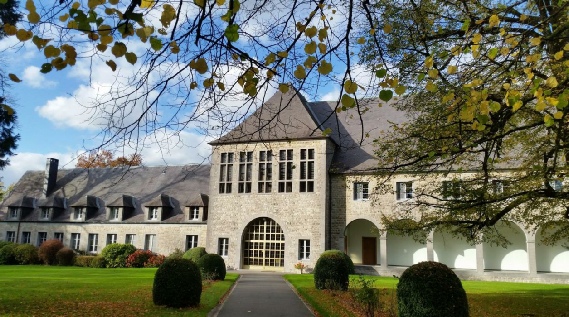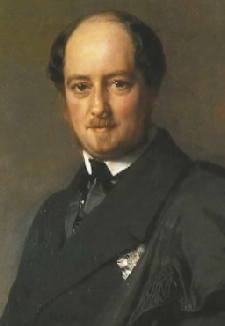Seo agus Siud Edition 7 June 2019
A Visit to Chimay
Reproduced from an article Mairin Barret wrote for the Saint Louis Newsletter of May 2002.

It was a wet and windy evening in December when Philomena Morris and I arrived at the Chateau of Chimay in southern Belgium. We had come to visit the lady of the Chateau, Elisabeth, Princesse de Chimay and when we got out of the car, there she was, waiting at the open doorway to receive us. It was thanks to Père Armand of the Cistercian Abbey of Scourmont that the visit had been arranged and though the princess did not know us, we knew she was aware of the connection between Chimay and St Louis
Family history
Our foundress’ mother, the beautiful Theresia Cabarrus, better known as Madame Tallien, is the connecting link. When Mère Thérèse was a little girl of five, her mother re-
We were not disappointed. It proved to be a treat every moment of it! The Princess’ vivacity, her encyclopedic knowledge and her gift for bringing the past to life ensured that we were entertained as well as instructed! She is a frenchwoman, and her excellent command of English she owes to her much-
The Shroud of Turin
Our first port of call was the chapel, a dark place with thick walls crowding in on us. It did not come as a great surprise to learn that this had been originally been the castle dungeon. But it was a surprise to discover that at one time, in the Middle Ages, the Shroud of Turin was housed in this same chapel. This naturally attracted pilgrims and the accompanying clink of money, until the Prince-

Centre of arts
Our next stop was the jewel of a little theatre, which replaced the original one Theresia had caused to be built in the grounds. She did much to restore Chimay to the grandeur it had known before the Revolution and in making it a centre of the arts, she added to its renown. She and her husband were both keen amateur musicians (he played the violin and she the harp) and she invited many of the best musicians of the day to Chimay. Thus was established the tradition of music-
Theresia
We followed the princess from room to room and marvelled at the multitude of ancestors whose portraits covered the walls. Even more fascinating was the fact that our hostess appeared to know many of them personally and had more than one amusing tale to tell about them. One character who particularly took my fancy was the twice-
There she was, as she is shown in the best known portrait of her, tall, well-
Theresia escapes execution
But another portrait showing Theresia in prison, her hair cut in readiness for execution on the morrow, was a reminder of how narrowly she escaped death. If the 21 year old Theresia had not been spared, what would the post-
Fascinating though the 'ifs' of history may be, we had enough of real history to keep us in conversation until we got to the princess’ own den, high up in one of the oldest parts of the chateau. Walls almost three metres thick make it a cosy place; it is here the princess works amid the books and boxes containing all sorts of family records. She told how, when there was a fire, they had to throw the archival boxes out of the window and, dentists bills and thousand-
It was raining harder than ever when we said good-





Joseph Philippe de Riquet 17th Prince of Chimay like his mother and half-
As well as donating Chimay lands for the Cistercian foundation of Scourmont Abbey, Prince Joseph Philippe de Riquet continued to be a benefactor and frequent visitor to the abbey When he died in 1886 and according to his wishes he was buried in the Abbey grounds in a monument erected by his son Joseph III and 18th prince of Chimay. He is also commemorated in a plaque in the chapel.
Some Further Information about the Chimay Connection

Today Scourmont abbey is a thriving monastery, famous for its beer and cheese production and with the chateau has put the town of Chimay firmly on the tourist trail.

Theresia and her husband are buried in the family vault beneath the sacristy of the town church and are commemorated in a plaque to right of the high altar, bearing the inscription A La Memoire de Marie Thérèse Ignace Comptesse de Cabarus, Princesse de Chimay né a Madrid 18 decedée à Chimay 1835.
In 1875 some years after the death of his wife and having suffered a number of financial difficulties, Joseph retired to live in a small cottage near London. He lived there until his death in 1886. The history section of the Scourmont website tells us that the prior of the monastery journeyed to Calais with Joseph’s son to accompany his remains back to the chateau. He was succeeded by his son, Joseph de Riquet de Caraman, the 18th Prince of Chimay and the then minister of foreign affaires in the Belgian government. His half-

Joseph de Riquet de Caraman,
18e prince de Chimay
Thérésia’s grandson



Joseph Philippe de Riquet
17th Prince of Chimay,
eldest son of Thérésia
Scourmont Abbey


Page 1 A Visit to Chimay by Mairin Barrett
Page 2 Mme Tallien, Princesse de Chimay by Barbara McArdle




He also had a commerative fountain monument erected in town square. Each of the four sides bears a statue, three of them, former princes of Chimay, including his own father the 16th prince. The fourth side is of his mother, la Princesse de Chimay, the former Thérésia de Cabarrus.


For those who would like to know more about Thérésia de Cabarrus Tallien, Princesse de Chimay,
her story follows on the next page.
The Princes’ Fountain



